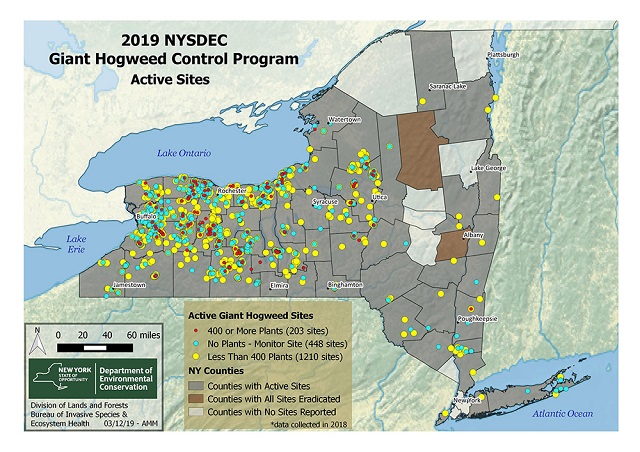| Copyright 2015 linkinglewiscounty.com all rights reserved privacy policy here |
| DEC Announces Progress in Efforts to Eradicate Dangerous and Invasive Giant Hogweed June 25, 2019 09:45 a.m. |
| Subscribe to our YouTube Channel |
DEC Announces Progress in Efforts to Eradicate Dangerous and Invasive Giant Hogweed Public Reminded to Report Giant Hogweed Locations, Especially as Plants Begin Blooming New York State Department of Environmental Conservation (DEC) Commissioner Basil Seggos today announced that statewide efforts to control giant hogweed are making substantial headway in eradicating this large, invasive, and dangerous plant. The Giant Hogweed Program, managed by DEC's Division of Lands and Forests, is in its twelfth year and has eradicated the plants from 623 sites, with another 448 plant-free sites being monitored. "With the assistance of our local partners, DEC's Giant Hogweed Program has made excellent progress in removing this dangerous invasive from New York communities," said Commissioner Seggos. "DEC not only works to eradicate this health hazard, but also to raise public awareness about how to recognize it, avoid it, and report it. We urge New Yorkers to stay vigilant and report potential giant hogweed to DEC, especially during the next few weeks as the plants begin to bloom and become more noticeable." Giant hogweed can cause severe skin and eye irritation, including painful burns and scarring when skin exposed to its sap becomes more sensitive to UV radiation. As a noxious weed, is unlawful to propagate, sell, or transport. In addition to health concerns, giant hogweed negatively impacts the state's ecosystem by crowding out native plants and contributing to soil erosion. Over the years, the diligence of DEC and its regional and municipal partners has led to the confirmation of 2,484 giant hogweed sites in 51 counties. The majority of active sites are concentrated in Central and Western New York. With landowner permission, crews visit and remove these invasive plants using root- cutting, herbicide, and umbel (flower head) removal control methods. DEC today released a 2018 Annual Report, which details the progress being made to identify giant hogweed and eradicate this noxious weed. During the 2018 season:
In addition to working with regional and municipal partners, the public has been an invaluable partner in DEC's Giant Hogweed Program, by submitting about 2,000 location reports via phone calls and e-mails each year. Giant hogweed is currently flowering, making this one of the easiest times of the year to locate the plant. Flowering giant hogweed are eight to 14 feet tall and have large, flat- topped clusters of small white flowers, a green stem with purple blotches and coarse white hairs, and large leaves up to five feet across. If a member of the public finds giant hogweed, please do not touch the plant, take photos of the entire plant (stem, leaves, flower, seeds), note the location, and send a report with the information via email to ghogweed@dec.ny.gov, text to 518-320-0309, or call the Information Line at 845-256-3111. If confirmed, DEC will contact the landowner to discuss control options. To report and learn more about other invasive species, the public can use the iMapInvasives database and mapping tool that helps share and coordinate information about detections and response efforts. New York State is taking a comprehensive approach to reduce the negative impacts of invasive species through control or removal activities, research, and spread prevention. Recently, Governor Cuomo announced more than $2.8 million in grants to DEC's partners across the state for a variety of projects to address invasive species, including giant hogweed. From July 7-13, 2019, New York State will hold Invasive Species Awareness Week featuring statewide events that encourage New Yorkers to help protect the state's resources from the negative impacts of invasive species. For more information about giant hogweed, including eradication efforts, plant ID, or to view the 2018 Annual Report, visit DEC's website. |
**PAID POLITICAL ADVERTISEMENT**


**Paid Political Advertisement**

*Paid Political Advertisement*
*Paid Political Advertisement*
*Paid Political Advertisement*










